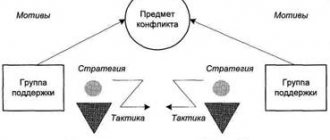Causes of conflicts in society
The emergence and development of conflicts is caused by the following groups of causes of conflicts :
1) objective;
2) organizational and managerial:
- structural and organizational;
- functional and organizational;
- personal-functional;
- situational and managerial.
3) socio-psychological:
- loss and distortion of information;
- unbalanced role behavior;
- different ways of assessing each other’s performance and personality.
4) personal:
- lack of psychological resistance to the negative impact on the psyche of stress factors of social interaction (conflict resistance);
- poorly developed ability to empathize;
- overestimated or underestimated level of aspirations and the associated level of self-esteem;
- character accentuations.
Objective causes of conflicts
The objective reasons for the emergence of social conflicts include mainly those circumstances of social interaction between people that led to a clash of interests, opinions, and attitudes. Objective reasons lead to the creation of a pre-conflict environment or situation.
Objective reasons for conflicts:
- natural collision of significant material and spiritual interests of people in the process of life;
- poor development of legal and other regulatory procedures for resolving social contradictions;
- lack of material and spiritual benefits that are significant for the normal life of people;
- lifestyle (material and everyday conditions, lack of opportunities to satisfy one’s basic needs);
- fairly stable stereotypes of interpersonal and intergroup relations that contribute to the emergence of conflicts.
Subjective causes of conflicts
Subjective causes of conflicts are mainly associated with those individual psychological characteristics of opponents, which lead them to choose a conflict method rather than any other method of resolving an objective contradiction. A rigid division between the objective and subjective causes of conflicts, and even more so their opposition, is unlawful. The seemingly purely subjective cause of a conflict may ultimately be based on a factor that has little dependence on a person, i.e. objective. And, perhaps, there is not a single conflict that was or was not somehow caused by objective and subjective factors.
The conflict attitude is characterized by the dominance of the subjective side. Subjective causes and conditions are the main component of the determination of the conflict. This includes the most diverse forms of manifestation and functioning of interests as conscious needs.
Disagreements between generations
Most often, disputes and disagreements among young people are resolved through conflicts. Conflicts between generations in a family are contradictions between parents and children. The origins of conflicts with parents among young people are the following:
A decrease in the authority of adults associated with increasing scientific and technological progress.- The source of the conflict among young people is the reluctance to adopt the experience of their parents and listen to their opinions. They want to live their own lives, to be independent in all fateful decisions, and they disdain their parents’ past.
- Spoiled and impunity, brought up by parents. From a very early age, a young man lives in abundance, without knowing any worries or troubles. Moving on to adulthood, he is completely unprepared to solve all the difficulties that appear on his way. He continues to enjoy parental benefits, but only with inflated demands.
- The following reason follows from the previous reason. Disrespectful attitude towards the older generation. Instead of a sense of respect, reverence for age, and sympathy, one’s own benefit comes to the fore.
- Financial problems in the family are a very common cause of disagreement between parents and children. A heightened sense of envy of the financial well-being of their peers pushes teenagers into quarrels and scandals in the family.
- Immoral behavior of parents in dysfunctional families.
- Parents living remotely from the teenager.
- Various everyday (at first glance, trivial) problems and the unwillingness of any of the warring parties to compromise.
Intergenerational conflicts that arise can have negative consequences . For example, reluctance to reconcile and understand the opponent’s point of view. The conflict situation is dragging on, misunderstandings are getting worse.
Or, for example, during any quarrel or scandal, a person experiences stress, his emotional state worsens, which invariably leads to negative consequences.
Organizational and managerial causes of conflicts
Structural and organizational reasons lie in the inconsistency of the organization's structure with the requirements of the activities in which it is engaged. The structure should be determined by the tasks that this organization will solve or is solving. However, it is almost impossible to achieve perfect compliance of the organization's structure with the tasks being solved.
Functional-organizational reasons are caused by suboptimal functional connections of the organization with the external environment, between the structural elements of the organization, and between individual employees.
Personal-functional reasons are associated with the employee’s incomplete compliance with professional, moral and other qualities with the requirements of the position held.
Situational managerial reasons are caused by mistakes made by managers and subordinates in the process of solving managerial and other problems (making an erroneous management decision).
Conflict: Conflict Management Techniques
Conflict is a clash between two or more strong motives that cannot be satisfied at the same time. Psychologically, the conflict is associated with the fact that the weakening of one motivating stimulus leads to the strengthening of another and a new assessment of the situation is required. Conflicts can have both positive and negative effects.
Types of conflicts
In the general classification, there are the following types of conflicts: intrapersonal conflict, interpersonal conflict, intragroup conflict, intergroup conflict, social conflict, interclass conflict, intraorganizational conflict, interethnic conflict and pedagogical conflict.
Causes of conflicts
The problem of identifying the causes of conflicts occupies a key place in the search for ways to prevent them and their constructive end. Without knowledge of the driving forces behind the development of conflicts, it is difficult to exert any effective regulatory influence on them. Based only on descriptive models of conflict, it is inappropriate to intervene decisively in its natural development.
Such intervention is justified when we not only know what is happening during a conflict, but can also answer the question of why these events develop this way and not otherwise. The construction of explanatory models is the result of a systemic genetic analysis of the conflict. It allows us to determine the causes of conflicts and reveal the driving forces of their development.
Objective factors of conflicts
The emergence and development of conflicts is determined by the action of four groups of factors and causes: objective, organizational and managerial, socio-psychological and personal. The first two groups of factors are mainly objective in nature, the third and fourth are mainly subjective.
Understanding the objective-subjective nature of the causes of conflicts will be very useful in the future in determining ways to prevent them and developing optimal strategies for people’s behavior in typical conflicts. The objective causes of conflict include mainly those circumstances of social interaction between people that led to a clash of their interests, opinions, attitudes, etc.
Objective causes of conflicts lead to the creation of a pre-conflict situation - an objective component of a pre-conflict situation. For example, in a workshop, the position of its manager is vacated, for which several engineers working in this workshop can apply. Since there is only one position, and there are several applicants, the interests of the latter are objective, i.e. regardless of the wishes of engineers, they collide.
Such a clash may or may not lead to conflict. However, if there was one applicant for this position, then there would be no conflict of interests of two or more engineers associated with the appointment to this position. In such a situation, a conflict associated with appointment to a vacated position would also be excluded, since there would be no objective reason for it.
Subjective causes of conflicts are mainly associated with those individual psychological characteristics of opponents, which lead to the fact that they choose the conflict method, and not any other method of creating an objective contradiction.
A person does not make a compromise solution to a problem, does not give in, does not avoid conflict, does not try to mutually resolve the contradiction that has arisen together with his opponent, but chooses a strategy of counteraction.
In almost any pre-conflict situation, there is the possibility of a conflict or one non-conflict way to resolve them. The reasons why a person chooses conflict, in the context of the above, are mainly subjective.
A brief examination of the nature of the relationships between the objective and subjective causes of conflicts can be noted as follows.
A brief examination of the nature of the relationships between the objective and subjective causes of conflicts can be noted as follows:
Firstly, a strict division between the objective and subjective causes of conflicts, and even more so their opposition, is apparently unlawful.
For example, if a standard procedure for filling vacant management positions was developed and collectively approved at the plant, then the number of conflicts associated with the struggle for promotion would become noticeably less.
But the development of such a procedure depends on the personal qualities of the plant managers, i.e. from the subjective factor. Suppose a person started a conflict because of his own increased aggressiveness, seemingly for a purely subjective reason.
However, it is possible that one of the main reasons for a person’s increased aggressiveness is the increased aggressiveness of the socio-economic environment in which he was born, raised and lives. Thus, the purely subjective cause of a conflict may ultimately be based on a factor that has little dependence on a person, i.e. objective factor.
Secondly, perhaps, there is not a single conflict that, to one degree or another, would not be caused by subjective and objective reasons. At the same time, it is difficult to find a pre-conflict situation that arose due to objective circumstances, which could not be resolved in a non-conflict way. In any interpersonal conflict, a subjective factor always plays one role or another.
If a person does not subjectively decide to start a conflict response, there will be no conflict. Therefore, almost any conflict has a complex of objective and subjective reasons.
Further development of systemic genetic analysis of conflicts is associated with the creation of a more strict classification of the causes of their occurrence, development and completion. One should not allow the causes of conflicts to be confused with the causes of changes in their dynamics, duration, severity of consequences, etc.
We are talking about distinguishing such concepts as “determinants”, “causes”, “factors”, “conditions”, “circumstances”.
The authors' analysis of more than 2,000 real interpersonal conflicts in relationships between middle managers shows that there are many objective reasons that cause conflicts. They are so diverse that they do not yet lend themselves to strict classification. The most common ones include the following:
1. Natural collision of significant material and spiritual interests of people in the process of their life. Employees working in the same team, as a rule, interact closely, jointly solving numerous problems. Employee interaction often continues during free time. In the process of constant interaction, people's interests may collide from time to time. This clash of interests creates an objective basis for possible conflict situations.
2. Poor development of legal and other regulatory procedures for resolving social issues. contradictions that arise in the process of interaction between people. For example, if a boss insults a subordinate, the latter is often forced to resort to conflict behavior to protect his dignity. A subordinate, of course, has the right to appeal against what he thinks is an incorrect action by his superior. However, such an appeal procedure is ineffective. In most pre-conflict situations of this kind, they prefer to either give in or go into conflict.
3. Lack of material and spiritual benefits that are significant for the normal functioning of people. The fact that we live in a society of possible deficits significantly affects the number and quality of conflicts between them. The main deficit today is money. If an organization has the opportunity to get a well-paid job for a limited number of employees, then natural conflicts arise between those who get this job and the rest of the employees. The distribution of housing, bonuses, and other material and spiritual resources is an objectively conflicting process.
4. The lifestyle of many Russians. This is the objective reason for some of the interpersonal conflicts associated with material and everyday conditions, insufficient financial resources to satisfy the sometimes basic needs of the family, and activities in which a person cannot always realize himself. It is obvious that a poor, unsettled person who has not realized his potential is more conflicted than a person who has successfully resolved all of the above problems.
5. Quite stable stereotypes of interpersonal and intergroup relations between citizens of Russia, the USSR, and the Russian Federation, contributing to the emergence of conflicts. These stereotypes have been formed over the last century, and perhaps even longer. From the moment of his birth, Soviet people were brought up in the spirit of class struggle, intolerance and mercilessness towards their class opponents and everyone who did not share our version of communist ideology.
The almost continuous struggle not only with the external enemy, but also with various internal “harmful elements” could not but affect the nature of interpersonal relationships of people as a whole.
We are not tolerant enough towards others, we easily hurt the self-esteem and other interests of others. Since we ourselves are humiliated and insulted by the state and often by those around us, we easily and without hesitation go into contradictions.
In addition to those mentioned, there are also an endless number of objective reasons, the influence of which on a person’s conflict behavior has not yet been studied. These include noticeable deviations from environmental standards in the human environment, in the characteristics of electromagnetic fields caused by solar activity or those. devices, various stressful situations in which a person finds himself. American scientists (psychologists) have experimentally proven that on hot days the probability of riots in the city can be several times higher than on cold days.
Organizational and managerial causes of conflicts
The second group of objective causes of conflicts is organizational and managerial in nature
Organizational and managerial causes of conflicts are associated with the creation and functioning of organizations, teams, groups:
Structural and organizational causes of conflicts
– Consists in the inconsistency of the organization’s structure with the requirements of the activities in which it is engaged. The structure of an organization should be determined by the tasks that this organization will solve or is solving. The structure is created for the tasks. However, it is almost impossible to achieve perfect compliance of the organization's structure with the tasks being solved.
The discrepancy between the structure of the organization and the tasks being solved arises for two reasons:
1) Mistakes are made when designing the structure of an organization. It is difficult to accurately predict all the tasks that the created organization will solve. It is difficult to create a structure that reflects the requirements of future activities in detail.
2) The tasks and activities of the company are constantly changing. Since the structure of the organization cannot change every week, there is a natural inconsistency between its activities.
The less flexibly the management of an organization adapts the structure to the changed requirements of activity, the more conflicts arise in the organization.
Functional-organizational causes of conflicts are caused by suboptimal functional connections of the organization with the external environment; between the structural elements of the organization; between individual workers.
External functional connections of the organization must correspond as much as possible to the issues being resolved and ensure their implementation. Effective operation of an organization is impossible without well-established functional connections with the external environment. Violation of these connections leads to conflicts. The functional relationships between individual employees of the team must meet the same requirements.
Personal-functional causes of conflicts are associated with the employee’s incomplete compliance with the professional, moral and other qualities of the requirements of the position held; any work requires certain professional knowledge and experience. If a person does not meet these requirements, then conflicts between them and managers are possible.
Situational and managerial causes of conflicts are caused by mistakes made by managers and subordinates in the process of solving managerial and other tasks. Making an erroneous decision objectively creates the possibility of conflicts between the authors of the decision and its executors. Failure of employees to fulfill the tasks set by management also raises the risk of conflict on this issue.
Social and psychological causes of conflicts
There are different points of view on the role of social psychology. reasons for conflicts. One of them is that the conflict is caused primarily by objective social-ec. determinants. At the same time, the presence of secondary social-psychiatry is obvious. aspects, parties in any conflict, and on the other hand, the presence of a private class of conflicts generated by social-psychic. factors.
Among the social-psychic. These are the causes of conflicts that are caused by direct interaction between people. Clear boundaries between the 4 groups have not yet been determined. There is no strict distinction. However, the study of conflicts made it possible to identify several typical causes of a socio-economic nature.
The second typical cause of interpersonal conflicts is the balanced role interaction of 2 people. Each person in the process of interacting with others plays more than 10 typical roles. These are the roles of boss, brother, father, sister, son, passenger, etc.
When a leader communicates, he usually considers himself senior. The interaction between a boss and his subordinates is complicated by the fact that it is carried out at 2 role levels: as a rule, a senior with a junior when solving official issues and as an equal with an equal, since the subordinate and the boss are equal citizens.
One of the typical reasons is misunderstanding; discrepancy in positions can often be caused by differences in views on the same thing, but approaches to the problem from different sides.
Conflict analysis showed that when assessing others they failed to do compared to the ideal who performed a similar job perfectly. The employee himself evaluates his results, i.e. As a result of the day, the methods of assessment may not only be the opposite. This leads to conflicts.
The personal causes of conflicts are associated, first of all, with the individual psychological characteristics of its participants. They are determined by the specifics of the processes occurring in the human psyche during his interaction with other people and the environment. environment.
If we talk about the causes of conflicts that are psychological, then an important one among them is the assessment of the behavior of another as unacceptable. If the partner’s actual behavior falls within the acceptable framework, then the interaction continues without conflict. Undesirable behavior can lead to the creation of a pre-conflict situation, and unacceptable behavior can lead to conflict.
Some conflicts occur due to the fact that the scope of acceptable behavior of his partner’s side is narrowed as a result of his egoistic orientation.
The choleric type of temperament, relatively more often, may be the reason for them to resolve contradictory situations in a conflicting way. This is due to the fact that choleric people have an unstable and mobile type of nervous system. One of the most common personal causes of conflicts is various character accentuations. They manifest themselves in the excessive expression of individual character traits or their combination in a particular person and represent extreme variants of the norm, bordering on psychopathy. Thus:
1. Without knowledge of the causes of the emergence and development of conflicts, it is difficult to count on their effective resolution (regulation). Factors and causes of conflicts are objective-subjective in nature and can be combined into 4 groups: objective, organizational and managerial, socio-psychological, personal.
2. The objective factors of conflicts are: the natural clash of interests of people in the process of life, poor development and use of normative procedures for resolving social issues. contradictions, etc.
3. The main organizational controls. The causes of conflicts are: structural-organizational, functional-organizational, personal-functional and situational-managerial.
4. To typical social-psychic. the causes of conflicts include: loss and distortion of information in the communication process; choosing different ways to evaluate performance results.
5. The main interpersonal causes of conflicts are: subjective assessment of the partner’s behavior as unacceptable; not enough social-psych. competence; inadequate level of aspirations, choleric type of temperament, character accentuations, etc.
Conflict Management
Conflict management presupposes the ability to maintain it below the level at which it becomes threatening to the organization, group, and interpersonal relationships. Skillful conflict management can lead to its resolution, that is, to the elimination of the problem that caused the conflict and the restoration of relationships between the parties to the extent necessary to ensure activities.
Conflict management can be expressed in resolution, termination, prevention, consensus building, prophylaxis, weakening, suppression, delay, etc.
Interpersonal conflict management is reflected in the well-known scheme of K. Thomas, which describes various strategies of behavior in a conflict situation depending on two main characteristics: the degree of persistence in satisfying one’s own interests and the degree of cooperation in satisfying the interests of others.
In Thomas's terminology, these are avoidance (evasion), accommodation, competition (suppression), compromise and cooperation.
Conflict development strategies:
— Competition: rivalry, suppression, open struggle for one's interests, defending one's position.
— Adaptation: changing one’s position, restructuring one’s behavior, smoothing out contradictions, abandoning one’s interests.
— Avoidance: avoidance of conflict, the desire to get out of a conflict situation without resolving it.
— Compromise: resolving disagreements through mutual concessions.
— Cooperation: joint search for a solution that satisfies the interests of both parties
R. Verderber and K. Verderber offer 15 general recommendations for conflict management:
1) Constant attention to the communication partner(s), providing the opportunity to speak.
2) Friendly, respectful attitude.
3) Naturalness, a reflection of your feelings and the feelings of your interlocutor.
4) Sympathy, participation, tolerance for weaknesses.
5) Emphasizing the commonality of interests, goals, and objectives. Finding in the partner's position what you can agree with.
6) Recognizing that the interlocutor is right where this is really the case.
7) Self-control, self-control, calm tone.
 Appeal to facts.
Appeal to facts.
9) Conciseness, laconicism, verbalization of the main key thoughts of the partner (partners).
10) Speaking out loud and explaining the understanding of the problem, asking questions to the partner(s) to clarify it.
11) Proposal to consider alternative solutions.
12) Demonstration of interest in solving the problem and willingness to share responsibility for this.
13) Increasing the importance of the partner.
14) Maintaining contact by verbal and non-verbal means throughout the entire communication situation.
15) In the event of an aggressive conflict situation, try to disconnect from it. Put up an emotional barrier (“Protection!”).
Conflict resolution:
1) Admit there is a problem.
2) Describe the conflict through:
- behavior (When you turn on the radio...)
- consequences (...I get distracted and can’t concentrate on work)
- feelings (...I feel anxious and annoyed)
3) Try not to let the other person change the topic of conversation (“Everyone has the radio on…”).
4) Offer a reasonable solution based on shared values (“We all have times when we need to focus…”).
5) Think about what to say before you confront the other person to make the request short and clear (“What should I say?”).
In conflict resolution, negotiations with the aim of achieving mutual agreement are of great importance. By putting forward specific proposals on specific problems, negotiating partners aim to simultaneously satisfy their interests and the interests of other parties. The result of the negotiations is a plan to solve the problem, clarification of the partners’ share of participation in its solution and mutual promises of specific actions.
The nature of organizational change in conflict
When Bob Dylan began writing songs in the 1960s, the youth of America keenly felt the winds of change. The leaders of large organizations, although criticized for their conservative economic and social views, were also clearly aware that a situation had arisen in which their survival depended on themselves, since bureaucrats with their instructions did not keep up with change.
Now, more than two decades later, change is happening even faster in many organizations, and experienced leaders in all organizations recognize the need to respond effectively to it.
Change is an issue that concerns all organizations. According to professors John Kotter and Leonard Schlesiewger, "Most companies and departments of large corporations find that they must undergo a moderate reorganization at least once a year, and a major reorganization every four or five years." Changes within an organization usually occur in response to changes in the external environment.
Since the early 1980s, the issue of performance management has become of great importance for American organizations, especially in the context of confronting the influence of foreign competitors and rising production costs. Attempts to increase productivity will necessarily require reorganization of some part of the organization.
Methodology for resolving conflict through problem solving
1. Define the problem in terms of goals, not solutions.
2. Once the problem is defined, identify solutions that are acceptable to both parties.
3. Focus on the issue, not the other party's personal qualities.
4. Create an atmosphere of trust by increasing mutual influence and information sharing.
5. When communicating, create a positive attitude towards each other by showing sympathy and listening to the other party's opinions, and minimizing expressions of anger and threats.
In 1974, in response to rising fuel costs, auto giant General Motors modernized its factories to increase production of more fuel-efficient vehicles. The initial investment alone amounted to $16 billion. Ten years after these initial steps, General Motors, together with Ford and Chrysler, is trying to implement other large-scale programs.
The increase in the number of cheap fast food restaurants such as McDonald's and Badger King has forced many small privately owned restaurants to lower prices, change menus and look for more economical cooking techniques. Ever since the Justice Department ruling allowed the manufacture and sale of telephone equipment to firms competing with A&T, the corporation continued to reorganize itself to become more marketing-oriented.
After learning how to treat polio, she survived only because she changed her goal and began to fight cerebral palsy. When compulsory military service was abolished in 1973, the US military began using television to change its image and appeal to individual needs for purpose and adventure.
The leadership was forced to relax some requirements for how military personnel should be dressed in off-duty conditions, as well as change the conditions of training and service in order to attract and retain modern youth.
Organizations operating in rapidly changing environments are more affected by change than those operating in more stable environments, and some parts of the organization are more affected by change than others. For example, the research and development department actually tries to introduce innovations, while the production departments want to operate in a relatively stable environment.
Although managers at all levels must respond to change, the effect of change and the form of response vary at different levels. For example, the actual decision to modernize was made by senior management at General Motors. Middle managers and technical specialists provided senior management with information on what changes were needed, alternative cost-benefit options for the reorganization, and technical alternatives to respond.
Lower-level managers were responsible for carrying out modernization at the level of competitive tasks and ensuring the correct operation of new machines and equipment, workers understood the new procedures and were able to meet product quality requirements when using the new technology.
Finally, change involves massive changes in organizational structure, new products, and fundamental changes in technology. The need to successfully implement such changes is obvious. But less obvious is the need to successfully implement, in Paul Lawrence's words, "the much needed 'small' changes that happen all the time - changes in work methods, in routine office procedures, machine or desk placement, management assignments and job titles."
While such “small” changes may not have much significance for the organization as a whole, they are extremely important for those specific people whom they directly affect. And since it is individuals who help achieve organizational goals, management cannot afford to ignore their potential responses to change.
When we talk about change in an organization, we mean management's decision to change one or more internal variables in the organization's goals, structure, objectives, technology and human factors. When making such decisions, management must be proactive or reactive, i.e. either to be active or to respond to the demands of the situation.
A change made to correct an error detected by a control system is a typical reactive action. An action taken to respond to an opportunity presented by the environment, even if no actual problem exists yet, is a proactive action.
When considering changes in this variable, the manager must remember that all variables are interrelated. Changing one variable will inevitably affect others. Harold Levitt comments on this: “The introduction of new equipment—for example, computers—may result in a change in structure (i.e., an organization's communications and authority structure), a change in human resources (their numbers, skills, attitudes, and activities), and a change in the level of task completion and even in the definition of tasks, since some tasks can only be actually completed for the first time now.”
As we discuss each variable further, we will give other relationships. Research has shown that innovation programs that focus on just one variable are not as effective as those that focus on multiple variables simultaneously.
Goals
For the survival of the organization, management must periodically evaluate and change its goals in accordance with changes in the external environment and the organization itself. Modification of goals is necessary even for the most successful organizations, if only because current goals have already been achieved. Often the need to change goals is detected through a control system, which should inform management about the relative effectiveness of the organization as a whole and each department separately.
Radical changes in goals will affect all other variables. For example, when IBM decided to gain a larger share of the personal computer market, it had to create a department responsible for new products, develop and implement manufacturing technology, train personnel to perform new tasks, and hire and train a large number of repair and maintenance technicians. computer maintenance.
Structure
Structural changes, part of the organizational process, refer to changes in the distribution of authority and responsibility, coordination and integration mechanisms, departmentalization, management hierarchy, committees and the degree of centralization. Structural change is one of the most common and visible forms of change in an organization.
They are a real necessity when there are significant changes in goals or strategy. When a large organization opens a new line of business, it creates subdivisions with primary responsibility for that line of business, and integrates the leadership of that line of business with the leadership of the rest of the organization.
For example, to enter the market with the diet drink Coca Cola, a special division was created. The addition of a new division to the existing ones also required changes in the system of relationships between functional services at the corporate level.
Structural changes have an obvious impact on the people component, as new people may join the organization and the chain of command will change. (Fear that structural changes will undermine established social and power relations often causes resistance to such changes.
Less obvious is the impact on technology, which is indirectly related to the new structure. For example, the information management system must change in order to supply the information necessary both for the new unit and for the control system over its activities.
Technology and challenges
Changes in the closely related variables of technology and tasks refer to changes in the process and schedule of tasks, the introduction of new equipment or methods, changes in regulations and the nature of the work itself.
Like structural change, technological change often disrupts social patterns, usually causing a revision of plans—a change in technology may require modifications to structure and workforce.
Changes in people involve modifications in the capabilities, attitudes, or behavior of the organization's personnel. This may include technical training, preparation for interpersonal or group communication, motivation, leadership, performance appraisal, management development, team building, implementation of programs to improve job satisfaction and morale, and improve the quality of work life.
Change in people, because it often causes fear due to unmet needs, is especially difficult to make effective. Not everyone, for example, wants to have more responsibility or learn more.
To successfully carry out changes in people themselves, they must be coordinated with other changes. Here is an eloquent example: an executive is sent to a seminar on methods for developing firm policy, and he is expected to take on additional responsibility. If this does not happen in practice, the money spent on preparation will be wasted money, and the manager may feel resentful.
A more subtle issue is the need for consistency in support when making changes in people. For example, a landmark study conducted at , found that lower-level managers who received people training were all able to implement new methods in their own jobs because their boss did not have similar training.
Used materials:
1) Conflict: types and methods of conflict resolution Shilin M.V.
2) Conflicts: types and methods of resolution Gagen A.D.
Social and psychological causes of conflicts
Due to possible significant losses and distortion of information in the process of interpersonal communication (limited vocabulary of a person in general and a specific person in particular, lack of time, deliberate withholding of information, difficulties in understanding due to information filters, inattention, difficulties in quickly understanding), a person does not take what he hears on faith. , but evaluates, drawing conclusions that differ and sometimes are opposite to what the interlocutor said.
Unbalanced role behavior in the interaction of two people leads to people not understanding that when discussing a problem, especially a complex one, the discrepancy in positions can often be associated not with a real difference in views on the same thing, but with an approach to the problem from different sides.
Different ways of assessing each other's performance and personality lead to the fact that the same work is assessed in completely different ways.
The objective source of conflicts is the value-normative system of society. In any conflict, along with the struggle for certain benefits, there is competition over values, including cultural patterns. Changes taking place in society necessitate the transformation of the normative value system. In addition, culture and subcultures constantly coexist in society, competing with each other. Under these conditions, contradictions between expectations and their implementation are inevitable.
The source of conflict is contained in the management process. Management is the choice of alternatives, the mobilization of resources, the use of power, which means forcing the governed to certain actions, limiting spontaneous behavior. In general, the management process includes the constant emergence and resolution of contradictions between the subject and the object of management. And this fills management activities with a series of conflicts.
0
School conflict situations
Conflicts born within the walls of the school are very multifaceted and inevitable. They sometimes happen because of trifles, sometimes for serious and compelling reasons. Disagreements can arise between students and between teacher and student.
Between students
Quarrels and hostility between students arise very often. The origins of conflicts among young people are due to the fact that a teenager at the age of 15-17 years begins a new personality formation: a feeling of independence, adulthood, and independence arises.
The adolescence of young people is characterized by deterioration in behavior, opposition to peers and adults, manifestations of stubbornness, a desire to free themselves from parental care, a desire to form groups, and manifestations of unreasonable cruelty. All this undoubtedly influences the emergence of disagreements. The most typical causes of school conflicts are the following:
- insults from classmates, gossip, singling out an outcast in the team and systematically humiliating him;
- unrequited love or rivalry for the opposite sex;
- status in society (for example, children of bosses and children of ordinary workers);
- financial situation of parents;
- misunderstanding and opposition of views and interests;
- desire for leadership;
- negative attitude towards peers who are singled out by teachers;
- personal insults.
Resolutions to contradictions are often negative . Teenagers experience negative emotions, relationships between students worsen, and therefore the situation in the entire team becomes tense. This affects the quality of learning material. Another negative side is the time costs: while the conflict lasts for one minute, post-conflict experiences last on average 12 minutes.
Teacher and student
Since the student and teacher spend a lot of time together, the possibility of disagreements and disputes, ending in outbursts of emotions on both sides, cannot be ruled out. Sometimes such situations drag on and become permanent. It becomes very difficult, and sometimes even impossible, to establish relationships. Among the many causes of conflict, the most significant can be identified:
- the teacher’s demands are ambiguous, incomprehensible, unreasonable;
- the teacher makes excessive demands on the teenager;
- the teacher does not fulfill his promises;
- the student believes that his knowledge is incorrectly assessed by the teacher;
- The teacher has a personal dislike for the student.
However, this is not a complete list of possible causes. Another classification of disagreements between teacher and student is as follows:
- Conflict of activity . These are disagreements in the learning process: the teacher gives the student a certain task, and the student either completes it partially and incorrectly, or does not complete it at all. This type of conflict occurs when a teacher works in this class for a short time (relationships with students are limited only to the educational process without taking into account the psychophysical characteristics of adolescents). Disagreements can also occur if a student is experiencing certain difficulties in learning.
- Conflict behavior . Often leads to complete misunderstanding between teacher and student. It is easier to prevent such situations than to correct them later. Taking into account the teenage period, the behavior of students can be aggressive, defiant, and unstable. It is important for the teacher to objectively assess the reasons for unsatisfactory behavior and not rush to conclusions.
- Personal relationship conflict . The source of the conflict between young people and teachers lies in mutual hostility for some reason, sometimes unfounded. This may be the social status of the parents, their financial situation and other factors.









